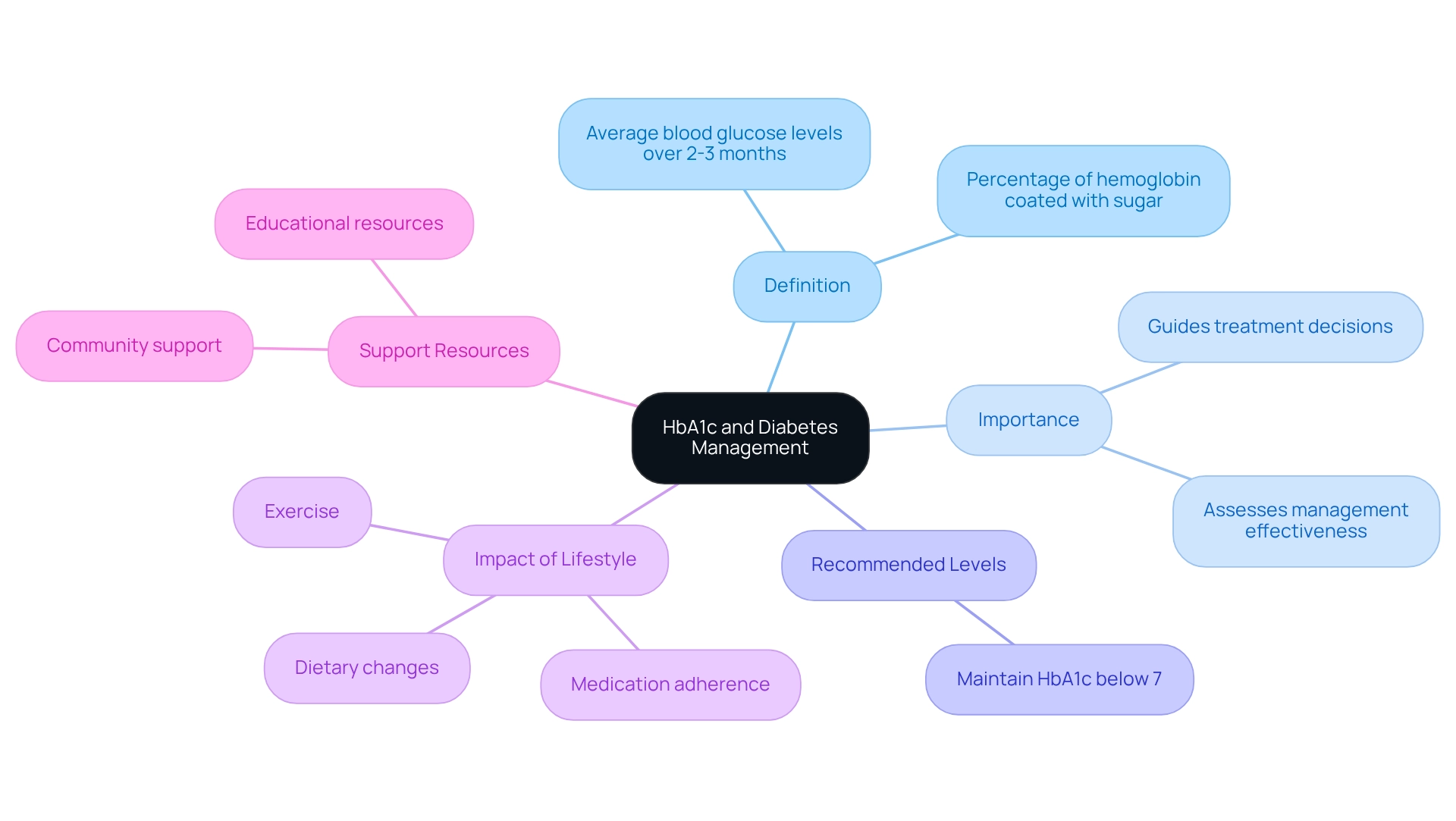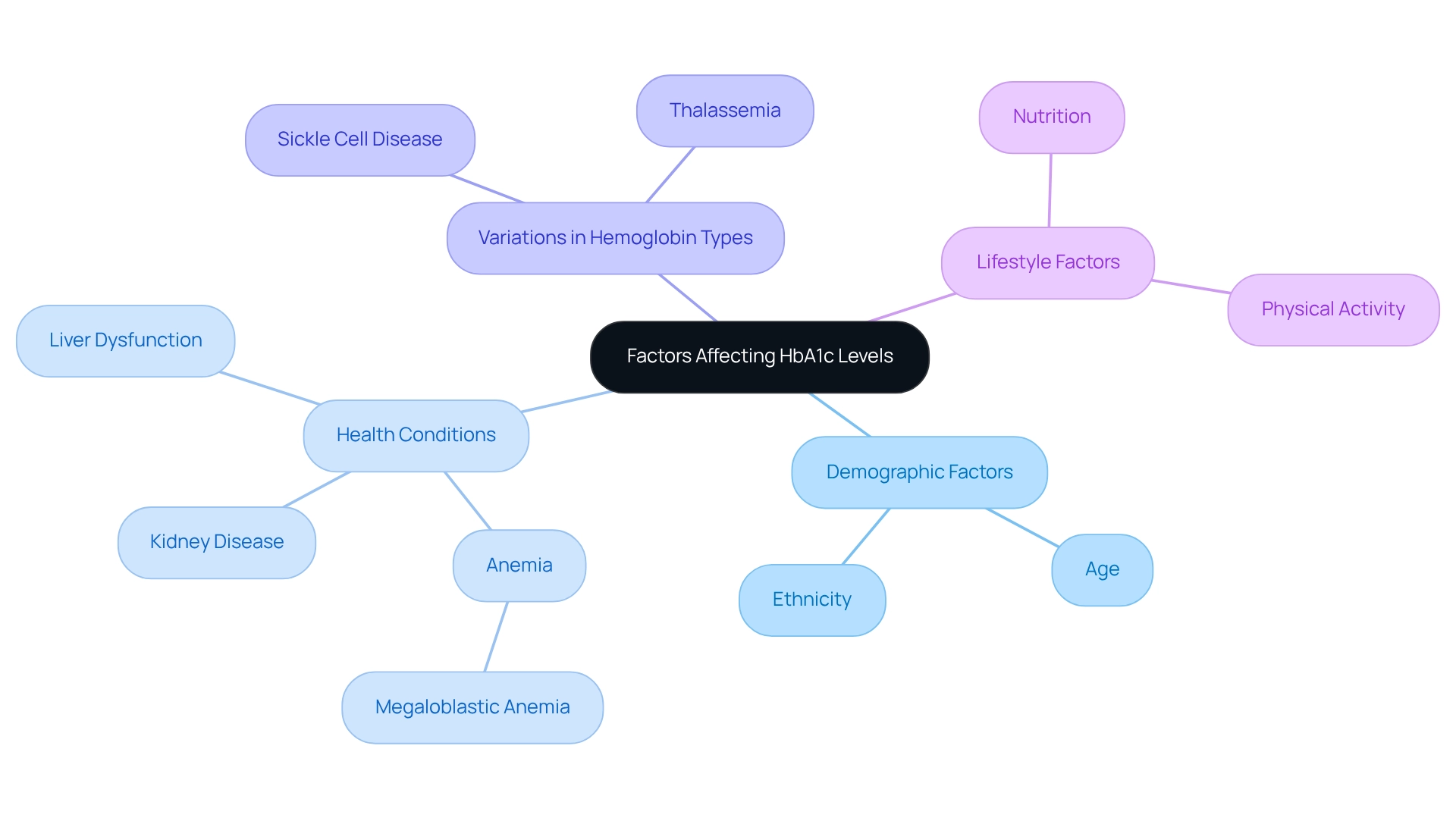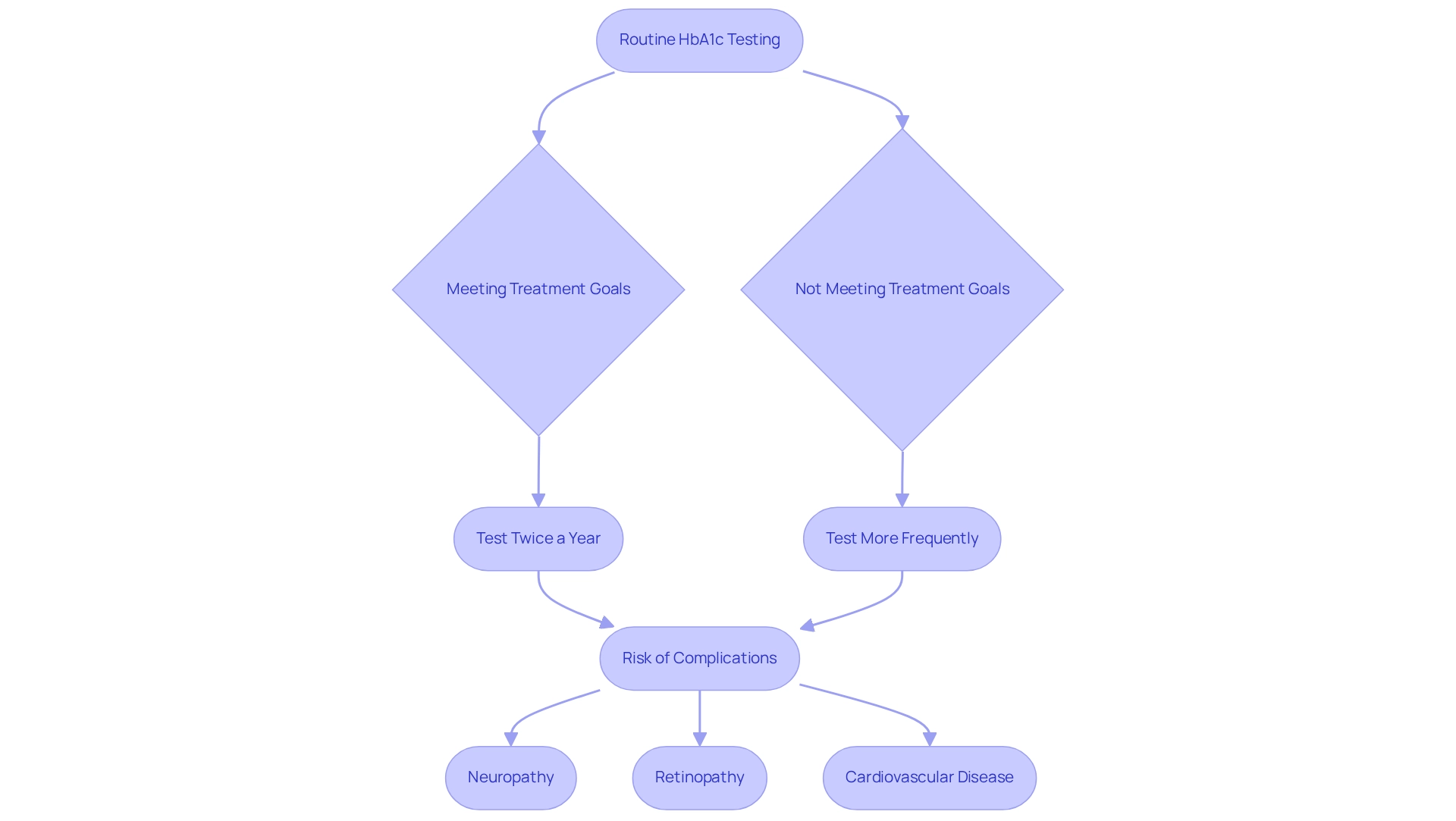Overview
This article highlights the health implications and management strategies related to an HbA1c level of 5.4%. While this level is generally considered normal, it is essential to monitor it regularly to prevent potential health risks. It's understandable to feel concerned about what this means for your health. A reading of 5.4% indicates effective glucose management, but it’s crucial to remain vigilant about lifestyle choices and regular testing. This proactive approach can help mitigate the risk of developing conditions such as prediabetes and cardiovascular disease.
As diabetes prevalence increases among youth and minority groups, staying informed and engaged with your health is more important than ever. You're not alone in this journey; many individuals face similar challenges and concerns. By prioritizing regular check-ups and making mindful lifestyle choices, you can take significant steps toward maintaining your health. Remember, we are here to support you every step of the way.
Introduction
In the realm of diabetes management, understanding HbA1c is crucial for maintaining optimal health. This vital blood test serves as a window into your average blood glucose levels over the past few months, guiding your treatment decisions and lifestyle adjustments. While a normal HbA1c reading is a positive indicator, levels above this threshold can signal potential health risks, including prediabetes and cardiovascular complications. It's important to know that various factors can influence HbA1c accuracy, making it essential for both you and your healthcare provider to interpret results carefully.
Regular monitoring of HbA1c not only empowers you to take charge of your diabetes but also plays a pivotal role in preventing long-term complications. You're not alone in this journey; many individuals face similar challenges. This article delves into the significance of HbA1c, the implications of different readings, and the importance of consistent testing in managing diabetes effectively. Together, we can navigate this path toward better health.
Define HbA1c and Its Role in Diabetes Management
Glycated hemoglobin is a vital blood test that reveals the average blood glucose levels over the past two to three months. Expressed as a percentage, it shows the proportion of hemoglobin that is coated with sugar.
For those facing blood sugar challenges, it’s generally recommended to maintain an HbA1c measurement below 7% to help minimize the risk of complications. This test is crucial for assessing how well your condition is being managed and plays a key role in guiding treatment decisions, especially in understanding your HbA1c for blood sugar control.
It can provide insights into how dietary changes, exercise, and medication adherence are affecting your health.
At T2DSolutions, we are committed to providing resources and community support to help individuals who have recently been diagnosed understand their blood sugar metrics and manage their condition effectively. Remember, you’re not alone in this journey; we are here to support you every step of the way.

Interpret HbA1c 5.4: Health Implications and Risk Assessment
A measurement of HbA1c 5.4% is typically considered normal, indicating efficient glucose management. However, it's important to understand that percentages above 5.4% can indicate a heightened risk for prediabetes and related conditions. Research shows that individuals with HbA1c readings above this threshold may face an increased risk of cardiovascular issues, such as coronary artery disease and stroke.
Moreover, the financial implications of diabetes management are significant. The excess medical costs per person associated with diabetes rose from $10,179 in 2012 to $12,022 in 2022. While a reading of HbA1c 5.4% is promising, it’s essential to engage in consistent monitoring and embrace lifestyle modifications to reduce the risk of rising blood sugar levels over time. This proactive approach can greatly impact long-term health outcomes, especially as the incidence of increased blood sugar markers continues to grow among adults.
It's also concerning to note the rising incidence of type 2 diabetes among youth, particularly in minority groups. This underscores the importance of awareness and effective management strategies. As highlighted by the Journal of the American Heart Association, remaining vigilant about these health implications is crucial. Remember, you're not alone in this journey; we are here to support you every step of the way.

Examine Factors Affecting HbA1c Levels and Accuracy
Understanding glycated hemoglobin values, specifically hba1c 5.4, is crucial for managing your health, and it's important to know that various factors can influence these results. Age, ethnicity, and specific health conditions can all play a role. For example, conditions like anemia, kidney disease, and liver dysfunction may lead to misleading blood glucose test outcomes. Research has shown that racial and ethnic differences can affect glycosylated hemoglobin readings; some groups might show lower values even when their average glucose levels are similar. This highlights the need to consider demographic factors when interpreting results related to hba1c 5.4, ensuring accurate diabetes diagnosis and management.
In particular, individuals with megaloblastic anemia may experience different results, as a study found that their hba1c 5.4 was 5.37% in the high hemoglobin group. This illustrates how specific medical conditions can mislead glycosylated hemoglobin results. Additionally, variations in hemoglobin types, such as those found in sickle cell disease or thalassemia, can significantly impact test accuracy. Lifestyle factors, including nutrition and physical activity, also play a vital role in influencing blood glucose levels and, consequently, A1c measurements.
As you navigate your health journey, it's essential to consider alternative measures of glycemic control, especially if you have conditions that may affect the accuracy of your blood sugar levels. Keep in mind that you are not on this path by yourself. Reliable information is key, and as Suhaib Radi noted, "The raw data supporting the conclusions of this article will be made available by the authors, without undue reservation," reinforcing the trustworthiness of the information provided.
Grasping these complexities is essential for both healthcare practitioners and patients alike. It enables accurate interpretation of blood glucose results and informed decision-making regarding blood sugar management. For those recently diagnosed, T2DSolutions serves as a valuable resource center, offering educational materials and community support to help you navigate these challenges and enhance your management of the condition. We are committed to assisting you throughout the entire process.

Highlight the Importance of Regular HbA1c Testing in Diabetes Care
Routine blood sugar level testing is vital for those managing high blood sugar. It plays a crucial role in monitoring long-term glucose management by assessing hba1c 5.4 and guiding treatment choices. The American Diabetes Association recommends that individuals with diabetes assess their blood sugar control, aiming for an hba1c 5.4, at least twice a year if they are meeting their treatment goals. If therapy changes or targets are not being met, more frequent assessments are necessary. Consistent monitoring of hba1c 5.4 allows for timely adjustments to diet, exercise, and medication, which ultimately reduces the risk of complications such as:
- neuropathy
- retinopathy
- cardiovascular disease
By emphasizing the importance of routine blood sugar tests, you can take proactive steps in managing your condition effectively.
At T2DSolutions, we understand that this journey can feel overwhelming at times. We are here to support you every step of the way by providing educational resources and community support to help you understand and manage your hba1c 5.4 levels. You're not alone in this journey; together, we can navigate the path to better health.

Conclusion
Understanding and monitoring HbA1c levels is essential for effective diabetes management. This vital blood test not only reflects average blood glucose levels over the past few months, but also serves as a crucial indicator of overall health. Maintaining an HbA1c level below 7% is generally recommended to minimize the risk of complications. If your readings are above 5.4%, it can signal an increased risk for prediabetes and other cardiovascular issues. Regular testing empowers you to make informed lifestyle changes and treatment decisions, ultimately enhancing your long-term health outcomes.
It's important to recognize that the accuracy of HbA1c readings can be influenced by various factors, including age, ethnicity, and underlying medical conditions. Understanding these influences is critical for both healthcare providers and patients to ensure proper interpretation of results. This knowledge highlights the importance of regular monitoring and the need for personalized management strategies tailored to your unique circumstances.
In conclusion, prioritizing consistent HbA1c testing and being proactive in your diabetes management can significantly reduce the risk of complications. Through education, community support, and informed decision-making, you can take control of your health journey. Remember, you're not alone in this journey. By staying vigilant and engaged, it becomes possible to navigate the complexities of diabetes and work towards a healthier future together.
Frequently Asked Questions
What is glycated hemoglobin (HbA1c) and what does it measure?
Glycated hemoglobin is a blood test that reveals the average blood glucose levels over the past two to three months. It is expressed as a percentage, indicating the proportion of hemoglobin that is coated with sugar.
What is the recommended HbA1c level for individuals facing blood sugar challenges?
It is generally recommended to maintain an HbA1c measurement below 7% to help minimize the risk of complications.
Why is the HbA1c test important for individuals with diabetes?
The HbA1c test is crucial for assessing how well diabetes is being managed and plays a key role in guiding treatment decisions, particularly in understanding blood sugar control.
How can the HbA1c test provide insights into health management?
The test can provide insights into how dietary changes, exercise, and medication adherence are affecting an individual's health.
What support does T2DSolutions offer for individuals recently diagnosed with diabetes?
T2DSolutions is committed to providing resources and community support to help individuals understand their blood sugar metrics and manage their condition effectively.



